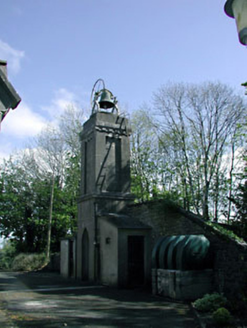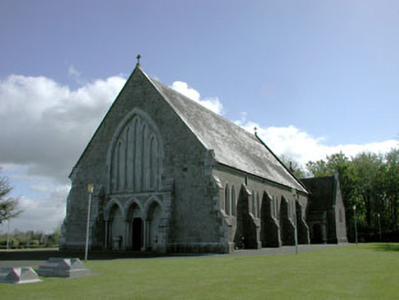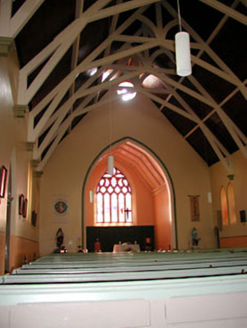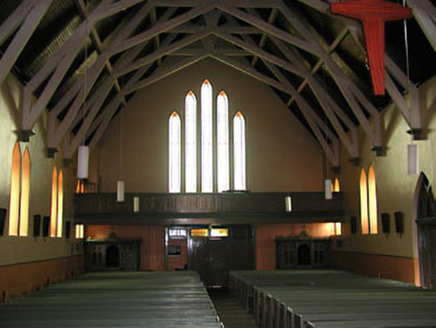Survey Data
Reg No
11900307
Rating
Regional
Categories of Special Interest
Architectural, Artistic, Historical, Social, Technical
Original Use
Church/chapel
In Use As
Church/chapel
Date
1860 - 1870
Coordinates
268986, 241569
Date Recorded
03/10/2002
Date Updated
--/--/--
Description
Detached six-bay double-height Gothic Revival Catholic church, built 1862-5, retaining early aspect comprising five-bay double-height nave with single-bay single-storey gabled projecting porch to north and single-bay double-height lower chancel to east having single-bay single-storey gabled sacristy projection to south-east. Gable-ended roofs with slate. Clay ridge tiles. Cut-stone coping to gables with finials to apexes. Ogee-profile cast-iron rainwater goods on cut-stone eaves course. Coursed cut-stone walls. Cut-stone dressings including stepped intermediary buttresses to north and to south. Paired lancet-arch window openings to nave. Cut-stone chamfered sills and surrounds. Fixed-pane windows (some with stained glass panels). Traceried (five-light) window to chancel in pointed-arch frame having cut-stone chamfered surround. Pointed-arch windows with profiled openings to arch. Fixed-pane stained glass windows. Traceried (five-light) window to entrance bay to west in pointed-arch frame having cut-stone surround. Lancet-arch openings. Fixed-pane windows. Square-headed door opening in cut-stone tripartite doorcase comprising series of three pointed-arches on cut-stone colonettes having moulded necking with recessed arches over. Cut-stone shouldered surround to door opening. Tongue-and-groove timber panelled door. Full-height interior open into roof. Carved timber pews. Carved Gothic-style timber confessionals. Timber panelled gallery to first floor to west on posts. Open timber roof construction. Lancet-arch chancel arch. Set back from road in own grounds. Lawns and tarmacadam forecourt to front.
Appraisal
Saint Mary’s Catholic Church is a fine and imposing building that appears to retain most of its original form and character. Composed on a simple plan, and with elevations of austere detailing, the church is an attractive example of the restrained use of the Gothic Revival style. The church is of social interest as the ecclesiastical centre for the Catholic population in the locality and, having been built through a system of voluntary contribution amongst the parish, the church can be considered an historic artefact, representing the emerging confidence of the Catholic population following Emancipation earlier in the century. The construction of the church in fine materials attests to this emerging confidence, and the stone work in particular represents the high quality of stone masonry traditionally practised in the locality. This is especially evident in the cut-stone detailing that has retained a crisp intricacy, for example the tripartite doorcase that forms the only obvious concession to decorative effect in the composition. The exterior of the church retains most of its original features and materials, including fittings to the openings, and slate roofs having cast-iron rainwater goods, while the interior is similarly preserved. The stained glass fittings to the interior are of some artistic merit, while the construction of the gallery to first floor, together with the open construction to the roof, is of technical or engineering interest. The church is attractively set in its own grounds, the flat quality of which serve to emphasise the monumentality of the design. Complementing the church is a small group of ancillary artefacts that are individually of interest: the tomb covers to the forecourt are of some artistic merit and, again, attest to the high quality of stone masonry in the locality; the belfry is a fine structure of some artistic merit, while the retention of the original mechanisms is of technical interest – elsewhere these have been lost during the conversion to electric power. Saint Mary’s Catholic Church is an important component of the architectural heritage of Garrisker, and can be considered one of a pair with Saint Brigid’s Catholic Church in Clogharinka, its sister church.







